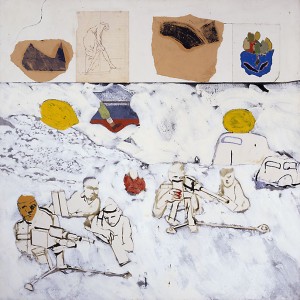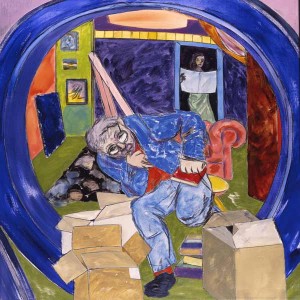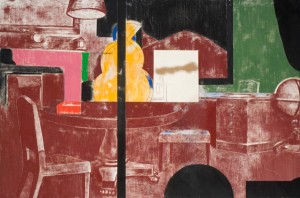A few years ago during a summer spent in Catalonia, I strolled through the port city of Sant Feliu de Guíxols. It is a special place: it was spared the transgressions of the Spanish coast’s building mania due to its fishing industry. It is not merely decorative but in fact successful in a particular industrial branch: producing cork. And here – nominally part of Spain but somehow a place all of its own – R.B. Kitaj and his wife spent the winter of 1953/54. Twenty years later, he bought a house in this town. What did it mean to him, this stubborn region that again and again rebelled against Spanish supremacy? → continue reading
Do You Know Catalonia?
R.B. Kitaj, the Bibliophile
Kitaj once said that books are for him what trees are for a landscape painter. His ateliers in the London neighborhood of Chelsea and in Westwood, Los Angeles, were crammed full of books, on shelves, around his easels and piled up on the floor.
He was already ranging through the cheap bookshops on 4th Avenue – the largest bookselling district in the world – on his way to Cooper Union when he was a student there. He found the modern classics like James Joyce, Ezra Pound, T.S. Eliot, and Kafka, as well as journals such as the “Partisan Review” and the American surrealist magazine “View.” In Oxford, his teacher Edgar Wind introduced him to the Warburg School and he bought a complete set of the famous “Journals of the Warburg Institute.” His visual imagination was fuelled by the illustrations for the “Afterlife of Antiquity,” copperplate engravings made according to ancient templates. In 1969, Kitaj published as silkscreens 50 book jackets from his personal library, in an edition that he called “In Our Time: Covers for a Small Library after the Life for the Most Part.” → continue reading
Kitaj’s Puzzle
I am impressed above all with R.B. Kitaj’s collage-like works, produced by superimposing numerous pieces of information and artistic citations. With their powerful colors, they radiate at first a kind of lightness and beauty.
The actual stories behind the motifs become clear only when one reads the texts that Kitaj attached to his pictures. These additional levels turn the collages into fraught projection screens for personal, historical, political, cultural, and religious themes and events. Suddenly text and image can no longer be viewed and understood separately. A putatively beautiful, gaily colored work becomes a vexating puzzle. → continue reading


